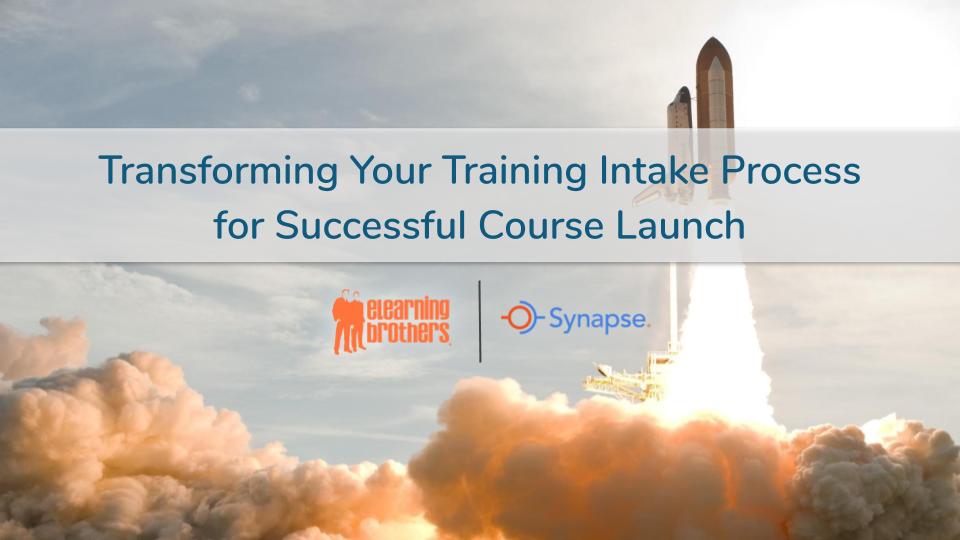Last week, we welcomed Laura Doerr, Senior & Lead Project Manager at eLearning Brothers, for a webinar called “Transforming Your Training Intake Process for Successful Course Launch.” Laura shared her framework for setting your training project team up for success long before project kick-off – a framework she calls “Readiness.”
Many L&D pros experience similar bottlenecks or challenges across multiple training projects. The Readiness framework helps you avoid and mitigate these challenges from the start, so you and your team can stay on track and be confident you’ve covered all the bases.
During the Readiness meeting, you’ll discuss all the project needs, potential roadblocks, timelines, roles & responsibilities, scope, success criteria, and all the other aspects of the project that have the potential to cause trouble down the line if not properly defined from the start.
Here are some of the key takeaways from the webinar:

The Big Let Down
During the webinar, Laura shared a couple of “Big Let Down” stories. These “Big Let Downs” happen when you think you’re on track, but something unexpected happens to derail the project right at the last moment.
“Big Let Downs” result in missed deadlines, slow reactions, and less effective project management. But the cause if not preparing for these issues in the first place.
Why Readiness before Kick-Off?
In the webinar, Laura outlined the difference between Readiness and Kick-Off and how Readiness is vital to a successful kick-off and overall project implementation.
The main difference is that Readiness prepares you for all eventualities so you can avoid nasty surprises on the kick-off call that derail the project. Once you’ve successfully completed the Readiness phase, kick-off actually means kick-off – the project can get underway straight away rather than ironing out kinks as you go.

Roles & Responsibilities
The clear definition of roles and responsibilities is hugely important for training projects. With subject matter experts (SMEs), learning professionals and other stakeholders involved, everyone should fully understand their contribution to the project.
During Readiness, ensure the following are covered:
- Who is the main point of contact?
- Who should be on correspondence?
- Who is the decision maker?
- Who can provide “Approvals”?
- Have you identified:
- – Stakeholders and SMEs
- – Anyone else who needs to be involved
- Are they ready to engage?
Project Scope
The project scope should be clearly defined. Everyone should understand the parameters and deliverables so they can stay on track and keep individual tasks highly focused on the end goal.
During Readiness, you should clearly state:
- This is what we’re going to build/create
- These are the tools we’re going to use to build it
- This is how we’re going to QA it
- This is how it will function when finished
- This is how it will not function when finished

Project Phases
Whether you use Agile, ADDIE, or another methodology to organize your training projects, ensure each phase of the project is sequentially laid out for the team.
For example, your project phases might include:
- Look and feel definition
- Design (storyboard)
- Develop (production)
- Quality Assurance (testing)
Decide exactly what should happen in each of these phases and who decides when the team is ready to move onto the next phase.
What happens if…
Contingency planning is essential. It’s impossible to predict what might come up to disrupt your projects, but the key is being prepared.
Come up with some worst case scenarios and define a process for how to overcome potential roadblocks to the training project.
Timeline
Sticking to a pre-defined timeline for any project can be challenging. But without one, your project team will struggle to stay motivated and it will be more difficult to collaborate and focus the efforts of SMEs and stakeholders.
During the Readiness phase, allow contributors to the project to help define the timelines rather than dictating them.
Ensure you’ve taken disruptors such as annual leave, national holidays, and the existing schedules of your project contributors into account.

Why you should consider Readiness
Laura and her team have seen dramatic results from leveraging Readiness to prepare for training projects. By using Readiness and taking a standardized approach to training intake, you can:
- Dramatically reduce “Big Let Down” moments
- Decrease timeline killers
- Run more efficient kick-off meetings
- Run into less bottlenecks that start with “you should have told me” or “I wish I had known”
- Identify risks you hadn’t considered
- Build confidence in the project
- Prevent timeline and budget busters
Want to check out the full webinar? Watch the recording on demand here!





